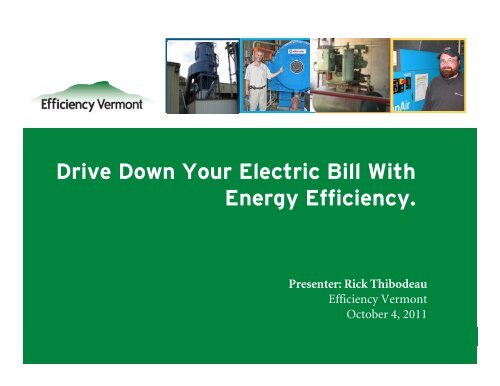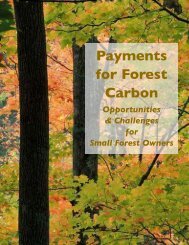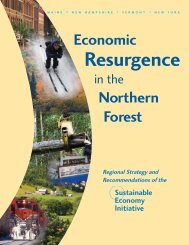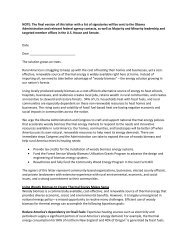Driving Down Electricity Bill with Energy Efficiency - Northern Forest ...
Driving Down Electricity Bill with Energy Efficiency - Northern Forest ...
Driving Down Electricity Bill with Energy Efficiency - Northern Forest ...
You also want an ePaper? Increase the reach of your titles
YUMPU automatically turns print PDFs into web optimized ePapers that Google loves.
Drive <strong>Down</strong> Your Electric <strong>Bill</strong> With<br />
<strong>Energy</strong> <strong>Efficiency</strong>.<br />
Presenter: Rick Thibodeau<br />
<strong>Efficiency</strong> Vermont<br />
October 4, 2011<br />
1
• This is an energy intensive industry and it will<br />
always be energy intensive.<br />
• It is tough to make payroll, maintain your<br />
equipment, compete in today’s market and stay<br />
current <strong>with</strong> new technologies.<br />
• There are cost effective steps that you can take to<br />
reduce your fixed energy costs.<br />
2
As Costs down<br />
Profits go up<br />
• You can reduce your fixed costs!<br />
• I invite you to listen, ask questions and think how<br />
you can apply these energy efficiency measures<br />
to your operation.<br />
• This workshop presentation will cover the most<br />
cost effective measures.<br />
3
Today’s Workshop<br />
1. Brief look at rate structures, demand charges, energy charges and power factor<br />
penalties.<br />
2. Variable Frequency Drives (VFD’s).<br />
• Applications<br />
• Misapplications<br />
3. Compressed air systems.<br />
• Compressors and system components.<br />
• Air Dryers<br />
• Leak repair<br />
4. Lighting<br />
• Federal regulation changes<br />
• Retrofits<br />
• Controls<br />
• New Technologies.<br />
5. Motors<br />
1. Efficient motor opportunities<br />
6. Buildings and Fuel savings.<br />
• Envelope<br />
• EVT HPF incentives.<br />
4
Rate Structures<br />
• Small usage customers pay per kWh. Time of day<br />
makes no difference.<br />
• Large usage pay additional demand charge for kW peak.<br />
• Single shift operations. This may be significant portion of total<br />
cost.<br />
• Large users rates change by time of use.<br />
• Large loads may also be subject to power factor<br />
penalty.<br />
5
Demand Rate Structures.<br />
• KW demand is calculated on a 15 minute Average.<br />
• Peak demands are never set during motor startup<br />
200 hp motor<br />
Soft start<br />
20 secs<br />
total start<br />
time.<br />
Time in Seconds<br />
6
Demand Reduction Strategies.<br />
1. <strong>Efficiency</strong> measures that reduce kW, on essential equipment<br />
and thus on during plant operation, always reduces demand<br />
and save energy.<br />
• Lighting is the best example.<br />
• Efficient motor.<br />
• Efficient transformer.<br />
• Any permanent kW reduction that normally runs when the peak<br />
demand is set.<br />
7
Demand Reduction Strategies.<br />
2. <strong>Efficiency</strong> measures that modulate equipment<br />
more efficiently can save significant energy and<br />
may reduce demand. Very equipment and time<br />
dependent.<br />
• Air compressor controls.<br />
• VFD’s.<br />
• Lighting controls.<br />
• HVAC controls.<br />
8
Demand Reduction Strategies.<br />
3. Load shifting to off peak hours will reduce demand. May not<br />
save energy.<br />
• Storing scrap and running chipper when plant is off.<br />
• Delaying any operation to off peak hours.<br />
• Limiting demand by shedding load.<br />
Load Duration Histogram<br />
9
Recovering cost through demand<br />
response contract.<br />
• Demand response companies will pay end users to<br />
shed load when required.<br />
• If you have the ability to shed a reasonable size<br />
load consider checking into on of these contracts.<br />
10
Power Factor Penalties.<br />
• If you have a power factor penalty charge on your<br />
utility bill.<br />
• Contact your utility representative.<br />
• There is generally a one year payback for<br />
correcting this.<br />
• Power factor correction does not save energy.<br />
<strong>Efficiency</strong> Vermont does not offer incentives of<br />
power factor correction.<br />
11
Variable Frequency Drives.<br />
VFD’s do one<br />
thing.<br />
Motor<br />
Fan<br />
• Only saves energy when the motor load is<br />
slowed.<br />
• <strong>Energy</strong> savings are best when applied to<br />
centrifugal fans or centrifugal pumps.<br />
12
VFD in Sawmill Head Saw Carriage.<br />
Load duration histogram of hydraulic carriage drive.<br />
Hours<br />
This system consumed 93 kW when not moving. Annual energy consumption 217,000 kWh.<br />
Regenerative drive VFD was installed. Estimated savings 200,000 kWh <strong>with</strong> 94 kW demand reduction.<br />
<strong>Efficiency</strong> Vermont provided custom analysis and incentives.<br />
13
Dust Collection Systems.<br />
14
VFD in Sawmill Boiler fans and kiln fans.<br />
• Good energy savings in boiler fan controls.<br />
• <strong>Efficiency</strong> Vermont would supply custom analysis and<br />
incentives.<br />
• Saving on boiler feed pump are limited due to high header<br />
pressure.<br />
• VFD on kiln Fans.<br />
• Savings are dependent on type of kiln and type of product.<br />
• Can be significant on hardwood kilns. (Varies <strong>with</strong> Species)<br />
• Custom <strong>Efficiency</strong> Vermont analysis and incentives.<br />
15
Some <strong>Efficiency</strong> Vermont Prescriptive Rebates.<br />
VFD’s in<br />
HVAC<br />
systems.<br />
Products must<br />
meet our<br />
efficiency<br />
requirements.<br />
16
Misapplications of VFD’s.<br />
• Motor soft-starters.<br />
• VFD’s consume 2 to 3% of the total motor rating.<br />
• If used solely for soft-start then install bypass relays.<br />
• Motor loads that do not vary over time and cannot<br />
be slowed down.<br />
• Pumping applications <strong>with</strong> high static head pressure.<br />
For more information visit http://www.cee1.org/<br />
17
For More information on VFD’s visit.<br />
ASDMaster software<br />
A description and ordering information for the software on U.S.<br />
DOE’s Industries of the Future<br />
BestPractices website (scroll down to the ASDMaster entry under<br />
Software).<br />
http://www.oit.doe.gov/bestpractices/just_need/motors.shtml<br />
Motors—U.S. Department of <strong>Energy</strong> Industries of the Future<br />
BestPractices<br />
This website contains tip sheets, case studies, and technical<br />
reports on motors and drives efficiency<br />
practices.<br />
http://www.oit.doe.gov/bestpractices/just_need/motors.shtml<br />
18
Compressed Air Systems.<br />
19
<strong>Efficiency</strong> Vermont Incentives.<br />
Products must be on our eligible products list. Call or visit our<br />
Website. We also have custom incentives.<br />
20
Compressed air system operation.<br />
• Set system header pressure at minimum possible.<br />
• Every 2 PSI reduction saves 1% of system energy.<br />
• Keep leaks to a minimum.<br />
• Repairing leaks can solve pressure drop issues which would<br />
allow header pressure reduction.<br />
• Do not dry air more than required.<br />
• Air dryers are often set below the required dew point.<br />
• For one shift operations over 100 hp.<br />
• <strong>Efficiency</strong> Vermont will cost share a compressed air audit on<br />
a 50% basis. This requires pre-approval. Call before<br />
committing to an audit.<br />
21
Changes to Lighting Regulations.<br />
• Now is the best time to replace outdated lighting systems.<br />
The U.S. Department of <strong>Energy</strong> passed regulations that ban<br />
the manufacture of T12 fluorescent lamps for sale in the<br />
U.S. after July 14, 2012. As a result, conventional<br />
replacement T12 lamps will no longer be available for<br />
purchase, and businesses using T12 lighting systems will<br />
need to upgrade to a more efficient lighting system at some<br />
point after July 14, 2012. <strong>Efficiency</strong> Vermont is offering<br />
increased rebates to replace these lighting systems<br />
through December 1, 2011.<br />
22
Current Rebates at <strong>Efficiency</strong> Vermont.<br />
Offer ends December 1, 2011.<br />
• Replace old lighting systems now and take advantage of this<br />
offer from <strong>Efficiency</strong> Vermont. Through the newLIGHT<br />
program, businesses can:<br />
• Receive significantly enhanced rebates on eligible efficiency<br />
upgrades.<br />
• Reduce lighting energy costs by saving 25 to 50% or more in<br />
energy use for each upgraded fixture.<br />
• Projects eligible for the newLIGHT Enhanced Rebates Program<br />
include:<br />
• T12 Upgrades and Controls<br />
• HID High-Bay Upgrades and Controls<br />
• Exit Sign Upgrades<br />
23
LED Rebates.<br />
24
Don’t Buy Just Any LED<br />
<strong>Efficiency</strong> Vermont premium rebates are available<br />
for high-performing LED products qualified<br />
through ENERGY STAR® or the DesignLights<br />
ConsortiumTM (DLC).<br />
Additionally, many LED products are eligible for<br />
standard rebates – those meeting the <strong>Efficiency</strong><br />
Vermont performance criteria and listed <strong>with</strong><br />
Lighting Facts.<br />
Check the LED Commercial Eligible Products<br />
Guide below the table for eligible products.<br />
25
Lighting Systems operation.<br />
• The best way to save lighting energy is to turn it<br />
off when not needed.<br />
• Install occupancy sensors in appropriate<br />
locations. Should control at least 75 Watts to<br />
make in cost effective.<br />
26
Efficient Motors<br />
• In Decmeber 2010 federal regulations made premium<br />
efficient motors a manufacturing requirement.<br />
• This applied to Class A or B, foot mounted 1hp to 200 hp.<br />
• There are motors that exceed these efficiencies.<br />
The same legislation required an increase in efficiency for<br />
other classes of motors. U-Frame motor<br />
• design C motor, close-coupled pump motor<br />
• footless motor<br />
• vertical solid-shaft normal thrust motor (tested in a horizontal<br />
configuration)<br />
• 8-pole motor (900 rpm) poly-phase motor <strong>with</strong> voltage of no more<br />
than 600 volts (other than 230 or 460 volts)<br />
27
New Motors and rewinds.<br />
o When purchasing a new motor always buy the<br />
most efficient available.<br />
• The differential cost is generally small and the payback<br />
can be fast.<br />
• Retrofitting an existing 3-phase motor, <strong>with</strong> an<br />
efficient motor, can have a long payback. For a<br />
reasonable payback the motor should have 6000<br />
annual operating hours and be heavily loaded.<br />
• If rewind is only option be certain the rewind shop<br />
follows best practices. Ordering a rewind to be<br />
completed quickly may cause best practices to be<br />
ignored.<br />
28
For more information.<br />
• For a list of motors that exceed premium efficiency:<br />
http://www.cee1.org/ind/motrs/CEE_MotorsListApril2010a.xls<br />
• For information on motors:<br />
http://www.eere.energy.gov/industry/bestpractices/pdfs/NN0116.pdf<br />
• Excellent explanation on motors see Cowern Papers at:<br />
http://www.baldor.com/pdf/manuals/PR2525.pdf<br />
29
Boilers<br />
30
Furnaces<br />
31
Wood Pellet Heating Systems.<br />
32
Thank You<br />
33








